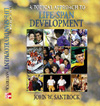 |  Life-Span Development: A Topical Approach John W. Santrock
Biological Process, Physical Development, and Health Biological Beginnings
Learning Objectives1.Discuss Darwin's concept of natural selection and its relationship to adaptive behavior. |
 |  |  | 2.Evaluate evolutionary psychology's emphasis on the importance of adaptation, reproduction, and "survival of the fittest" with respect to explaining behavior and explore:- Baltes' view of the benefits of evolutionary selection
- how cultural needs increase with age
- Bandura's argument for a bidirectional view of evolutionary and environmental influences
|
 |  |  | 3.Understand the genetic foundations of life, including:- the structure and function of chromosomes, DNA, and genes
- the distinction between mitosis and meiosis
- genetic principles (such as dominant-recessive), behavior genetics, molecular genetics, and chromosome and gene-linked abnormalities
|
 |  |  | 4.Explain heredity-environment interaction, including passive, evocative, and active genotype-environment correlations and the ways in which genetic loading establishes a propensity for behavior to develop according to particular developmental trajectories. |
 |  |  | 5.Describe the germinal, embryonic, and fetal periods of development, as well as the method and purpose for the prenatal tests: amniocentesis, ultrasound sonography, chorionic villus sampling, and the maternal blood test. |
 |  |  | 6.Address teratology, hazards, and protective factors that may affect the unborn child during prenatal development, including: - prescription and nonprescription drugs
- psychoactive drugs
- environmental hazards
- maternal factors
- paternal factors
- avoiding vulnerabilities
|
 |  |  | 7.Describe the three stages of birth, the various childbirth strategies and methods of delivery, and the commonly used measures of neonatal health and responsiveness; distinguish between preterm infants and low-birthweight infants; and comment on whether bonding is critical for the competent development of infants and the well-being of their mothers. |
|



 2002 McGraw-Hill Higher Education
2002 McGraw-Hill Higher Education